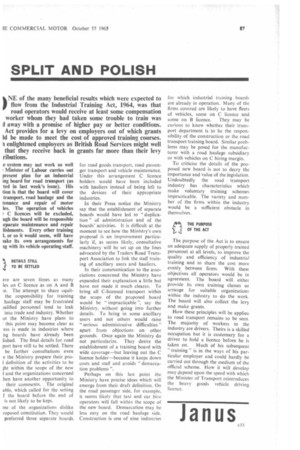SPLIT AND POLISH
Page 89

If you've noticed an error in this article please click here to report it so we can fix it.
)NE of the many beneficial results which were expected to flow from the Industrial Training Act, 1964, was that road operators would receive at least some compensation worker whom they had taken some trouble to train was d away with a promise of higher pay or better conditions. Act provides for a levy on employers out of which grants Id be made to meet the cost of approved training courses. 4 enlightened employers as British Road Services might well that they receive back in grants far more than their levy ributions.
e system may not work so well Minister of Labour carries out present plan for an industrial ing board for road transport (as .ted in last week's issue). His Lion is that the board will cover transport, road haulage and the tenance and repair of motor les. The operation of vehicles C licences will be excluded, ugh the board will be responsible cparate maintenance and repair lishments. Every other training I, or so it would seem, will have take its own arrangements for rtg with its vehicle operating staff.
DETAILS STILL TO BE SETTLED
ere are seven times as many les on C licence as on A and B :e. The attempt to share cquitthe responsibility for training haulage staff may be frustrated ialified personnel tend to leak into trade and industry. Whether ot the Ministry have plans to • this point may become clear as .ess is made in industries where ng boards have already been lished. The final details for road port have still to be settled. There be further consultations even
e the Ministry prepare their pro definition of the activities to be ;lit within the scope of the new and the organizations concerned hen have another opportunity to their comments. The original able, which called for the setting f the board before the end of is not likely to be kept.
rne of the organizations dislike roposed constitution. They would preferred three separate boards for road goods transport, road passenger transport and vehicle maintenance. Under this arrangement C licence holders would have been included with hauliers instead of being left to the devices of their appropriate industries.
In their Press notice the Ministry say that the establishment of separate boards would have led to " duplication " of administration and of the boards' activities. It is difficult at the moment to see how the Ministry's own proposal is an improvement particularly if, as seems likely, consultative machinery will be set up on the lines advocated by the Traders Road Transport Association to link the staff training of ancillary users and hauliers.
In their communication to the associations concerned the Ministry have expanded their explanation a little but have not made it much clearer. To bring all C-licensed transport within the scope of the proposed board would be "impracticable ", say the Ministry, without going into further details. To bring in some ancillary users and not others would raise "serious administrative difficulties" apart from objections on other grounds. Once again the Ministry do not particularize. They desire the establishment of a training board with wide coverage—but leaving out the C licence holder—because it keeps down costs and staff and avoids "demarcation problems ".
Perhaps on this last point the Ministry have precise ideas which will emerge from their draft definition. On the road passenger side, for example, it seems likely that taxi and car hire operators will fall within the scope of the new board. Demarcation may be less easy on the road haulage side. Construction is one of nine industries
for which industrial training boards are already in operation. Many of the firms covered are likely to have fleets of vehicles, some on C licence and some on B licence. They may be curious to know whether their transport department is to be the responsibility of the construction or the road transport training board. Similar problems may be posed for the manufacturer with a road haulage subsidiary or with vehicles on C hiring margin.
To criticise the details of the proposed new board is not to decry the importance and value of the legislation. Undoubtedly the road transport industry has characteristics which make voluntary training schemes impracticable. The variety and number of the firms within the industry would be a sufficient obstacle in themselves.
THE PURPOSE
‘41 OF THE AC1' The purpose of the Act is to ensure an adequate supply of properly trained personnel at all levels, to improve the quality and efficiency of industrial training and to share the cost more evenly between firms. With these objectives all operators would be in agreement. The board will either provide its own training classes or arrange for suitable organizations within the industry to do the work. The board will also collect the levy and make grants.
How these principles will be applieo to road transport remains to be seen. The majority of workers in the industry are drivers. Theirs is a skilled occupation but it is customary for a driver to hold a licence before he is taken on. Much of his subsequent "training" is in the ways of his particular employer and could hardly be carried out through the medium of the official scheme. How it will develop may depend upon the speed with which the Minister of Transport reintroduces the heavy goods vehicle driving licence.








































































































































